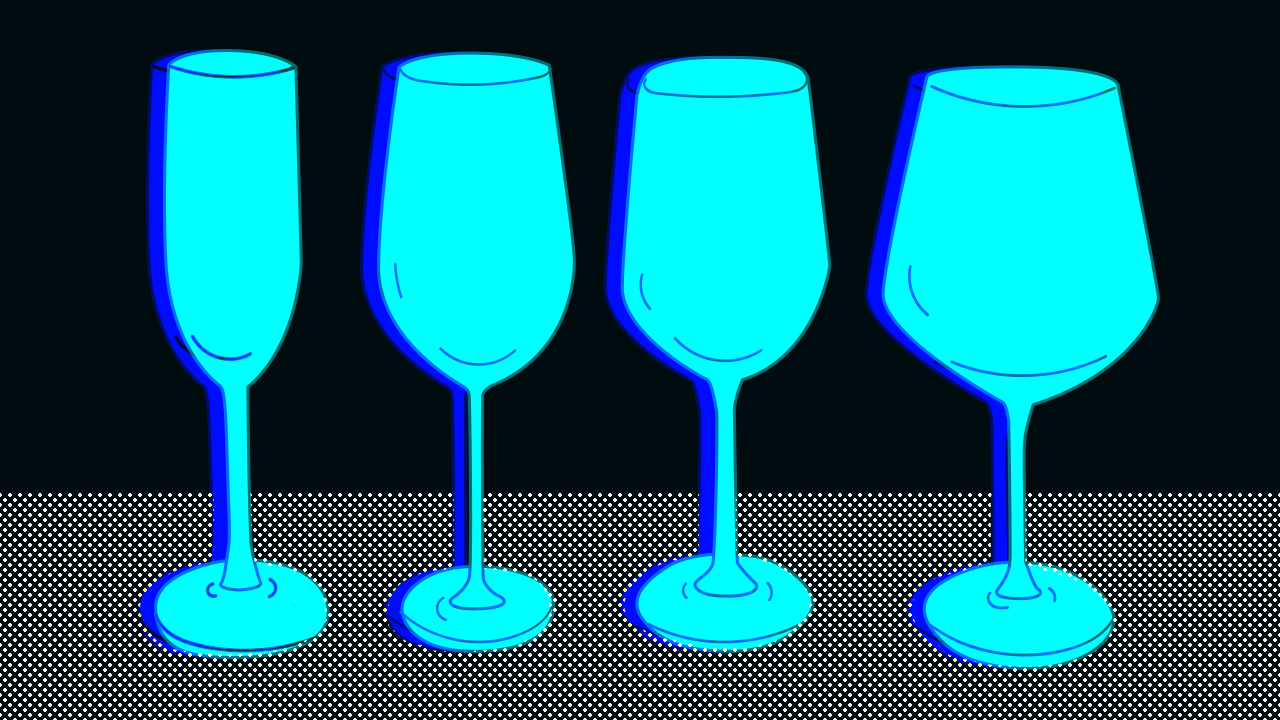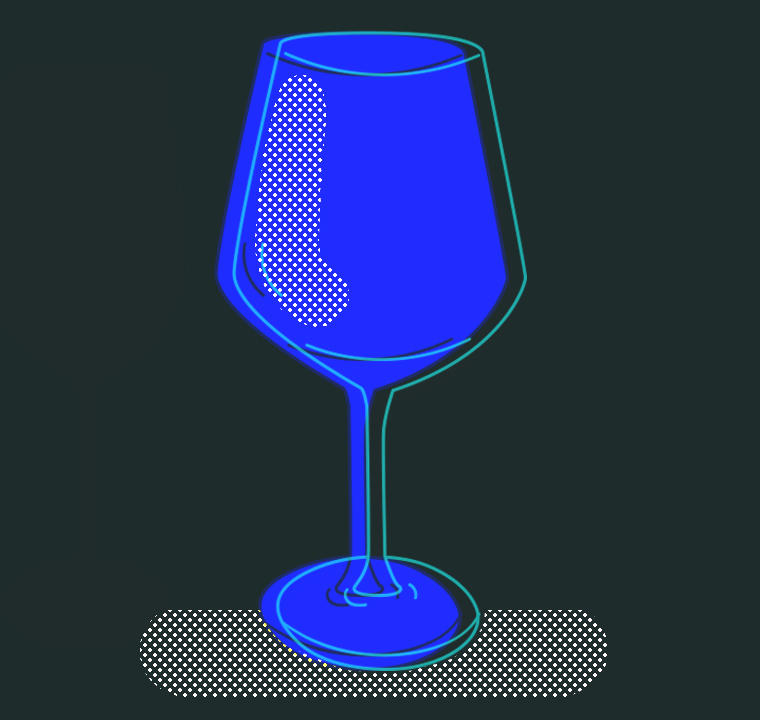A Master Sommelier Schools Us In How To Choose A Wine Glass
Wine glasses can get very expensive and very complicated very quickly.
Wine glasses have confounded us for a while now. Why did champagne glasses change from little saucers to long flutes? Why do some look like fishbowls and others not? Why are we pretty sure we're putting the wrong type of wine in just about every glass?

When you're as clueless as we are, you'd best turn to an expert. Lucky for us, Alpana Singh was happy to help. The former host of Check, Please!—an immensely popular restaurant review show on Chicago TV—and the youngest female ever to pass the final level of the master sommelier exam now runs two restaurants in the Chicago area: Terra And Vine and The Boarding House. The latter is only a few blocks away from our offices, so on a recent afternoon Singh generously sat down to educate a dummkopf like myself on the considerable science behind the shape of wine glasses.
Singh starts out practically: "The thing about wine glasses, they can get very expensive and very complicated very quickly." she said. "And my problem with wine glasses is, yes, they're beautiful, but you use them when you're tipsy and they break. So my rule of thumb is buy the best glass you can afford that fits your lifestyle."
Whatever your price range, what wine glasses do you need to have in your arsenal? Singh likes to break wineglasses down into the classic four.
Sparkling Wine
Singh starts out by holding up the flute she uses in her restaurant. She tells me there's an etch at the bottom of the glass, and it's this scratch that causes bubbles to form in your champagne.
But what about those old-school, Gatsby-esque champagne coupes? They're virtually the opposite of a flute. Singh tells me that the shape was modeled after the curvature of Marie Antoinette's breast. The problem with this shape, she says, is it's too wide of an area and the bubbles disappear.
Surprisingly, Singh says that some champagne experts use an entirely different glass from the flute or coupe: a small white wine glass. "The idea here is that you give it a big bowl so that you can smell the aroma, but it's also kind of tapered in so you can still keep the bubbles. A lot of champagne aficionados prefer a basic white wine glass to drink their champagne out of because it allows you to experience more of the aroma."
So my takeaway: Flutes are lovely if you enjoy the bubbles, but perhaps I should consider cheap, small wine glass for my champagne-drinking experience.
All-Purpose Wine Glass
I'm admiring this all-purpose glass that Singh uses throughout her restaurant when she tells me it comes from a surprising-yet-not source: Costco. "This is the glass that actually I have at home. They were $2.50 a glass, and what I like about it is that you can throw it in the dishwasher. It's got the stem and the bowl and it allows you to swirl." It's her go-to glass for everything.
I toss out one of the few wine facts that I thought I knew: that if the wine is red, it's okay to touch the bowl, but if it's white, that's bad, because you'll warm up the wine too quickly? Turns out I don't even really have that one right, as Singh replies, "It depends. Most people drink fairly quickly, so it doesn't necessarily matter. But this glass also allows the stem for swirling. I like to make the analogy that there's nothing wrong with flats, but there's something very exquisite about stilettos." Which I think makes the stemless glasses I favor at home the wine version of Birkenstocks.
And what about the importance of swirling? Turns out, all those waiters at restaurants pouring me less than half a glass weren't trying to slow down my rate of drinking, but to encourage me to drink my wine correctly. "You never want to fill the bowl more than about less than halfway full," Singh said. "You want to fill it to just below the widest part of the glass. Just shy of the widest part. Because when you go to swirl it..."
And then came the dawn. I interjected: "You want it to stay in the glass." Singh nods. "Right. That's one of the reasons why when you go out to dinner and the sommelier only pours you a little bit. It's not because they're trying to pace you. It's because that's the proper way so you can swirl the wine. And what swirling does is it increases the aroma potential. So the all-purpose glass should give you the bowl of the burgundy glass but the shoulders of a Bordeaux glass."
Burgundy and Bordeaux
So now that I understand what a bowl is, I need to learn about shoulders, which is not a term I have ever heard before related to glasses. Singh holds up one of those giant fishbowl glasses I've always wondered about: a burgundy glass.
"What a burgundy glass does is trap the aroma, locking it in like the fishbowl. It's basically a cognac sifter on stilts. That's a burgundy glass. Whereas my Bordeaux glass has really high sides [or shoulders]. Notice how high it goes when I swirl it. So what this does it is creates the shooting action so that it opens up the wine. Because then it's maximum oxygen exposure and then it opens up the wine."

This is why these two glasses are made for different grape varietals: Thin-skinned grapes, which are all about the aroma (Vernashen, Gamay, Beaujolais, Dolcetto, Barbera), get the burgundy glass. Thicker-skinned grapes (cabernet, Malbec, petit verdot) that need opening up get the Bordeaux glass for swirling.
"That's where the sheeting action is needed, so that's where you have the higher shoulders. Not that the aroma is not important. It is. But it's more about getting some air into the glass."
This is all well and good, but most of us have limited wine palates (guilty), as well as limited kitchen space (same). For the average wine drinker like ourselves, Singh focuses on three categories: all-purpose "that's the one where you can go to Costco and knock yourself out"; specialty glasses "I would get the burgundy bowl;" and diva glasses "Have like six on hand and then invest in nicer, bigger, larger. We call them diva glasses, for obvious reasons."
Sadly, as I mentioned my wine glass collection right now mostly consists of stemless, which we bought a case of at either Costco or Ikea after we lost most of our stemmed wine glasses once we had kids and practically everything breakable in the house was destroyed. According to Singh, I'm not alone: "I actually had dinner with Maximillian Riedel one night. He's the heir to Riedel; he runs the company now. And he said he invented the stemless glassware. He said, 'I live in New York. I don't have cabinet space and they stack and it was just something that was more youthful and more fun.'" And fortunately or unfortunately, people usually drink wine so quickly, there's not much danger that the white will be ruined by getting warmed up from someone holding it in a glass without a stem.
Now that I know enough about the reasons that wine glasses are the way they are to amaze my friends at parties, I also know that the market runs the gamut from Target (Singh's favorite retailer for glasses) to specific glasses for specific varietals "that direct the wine to the part of your palate where a Syrah should be," Singh says. Ultimately, she doesn't think it's necessary for the majority of us who aren't master sommeliers. "I just think you go buy the best most affordable wine glass you can find," Singh says.
As we wrap up, Singh drops one last bit of knowledge about wine glasses that I've never really considered, but that I instantly recognize as perfect: "Wine glasses make the perfect gift because everybody always needs them. Because" —and she ends our conversation just like she began it—"they break."



